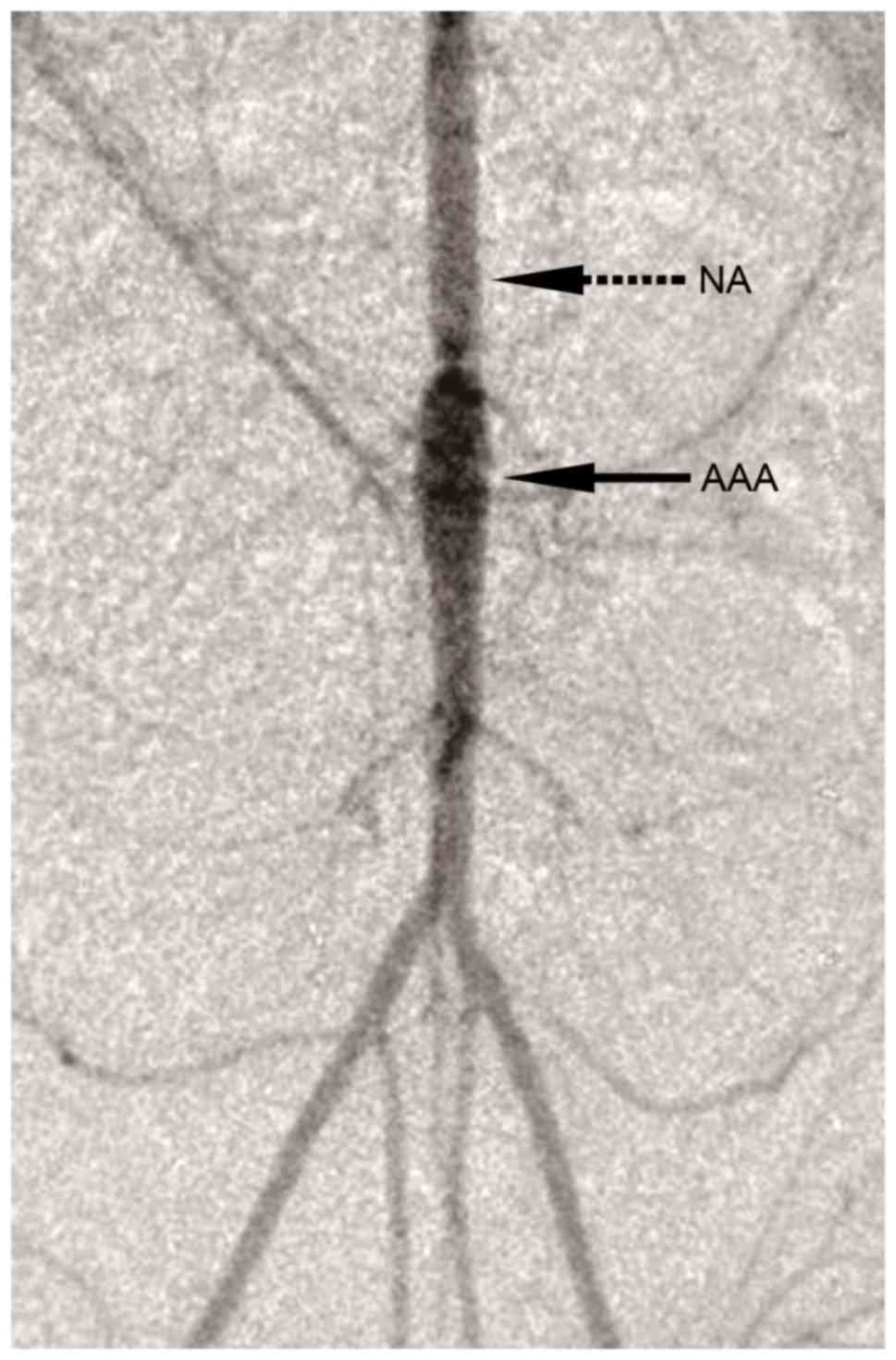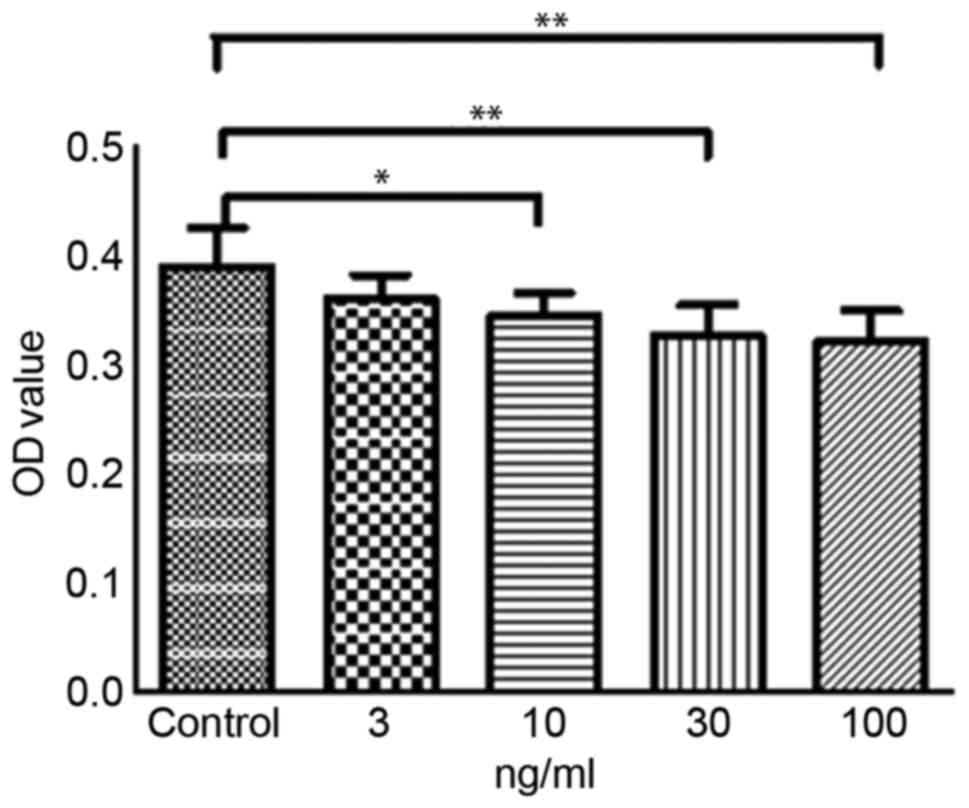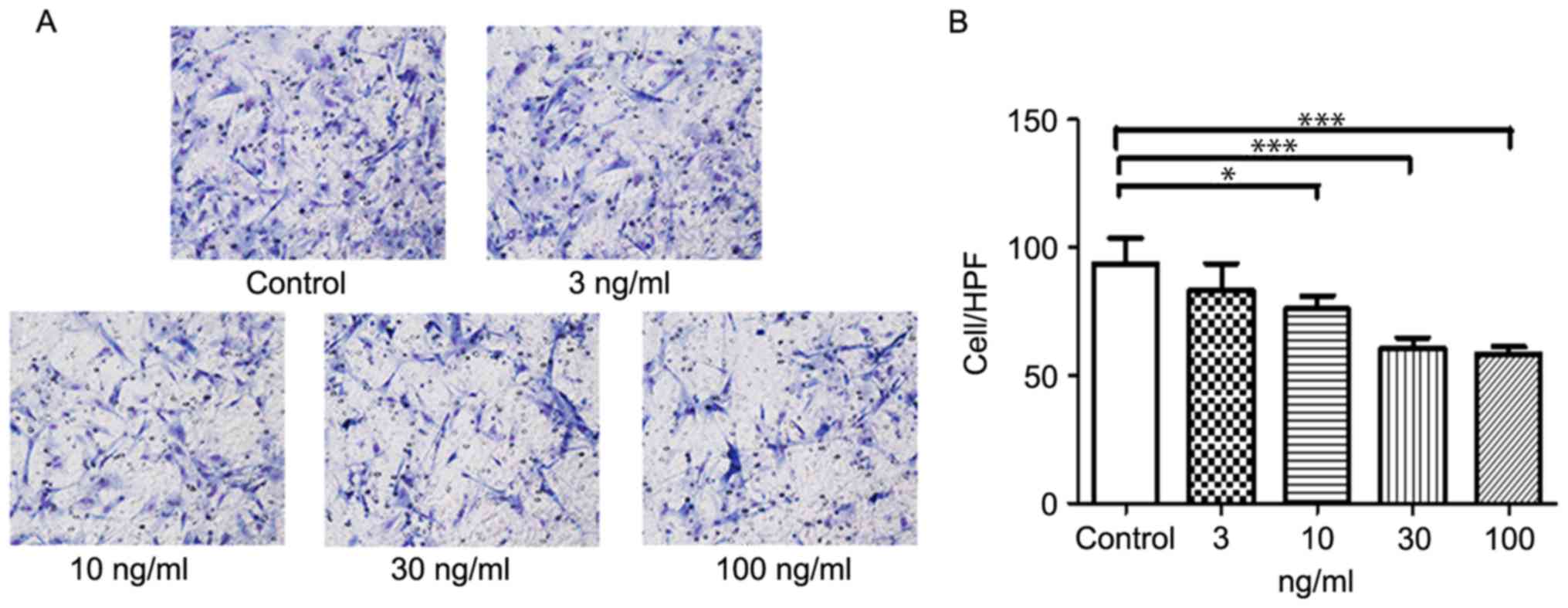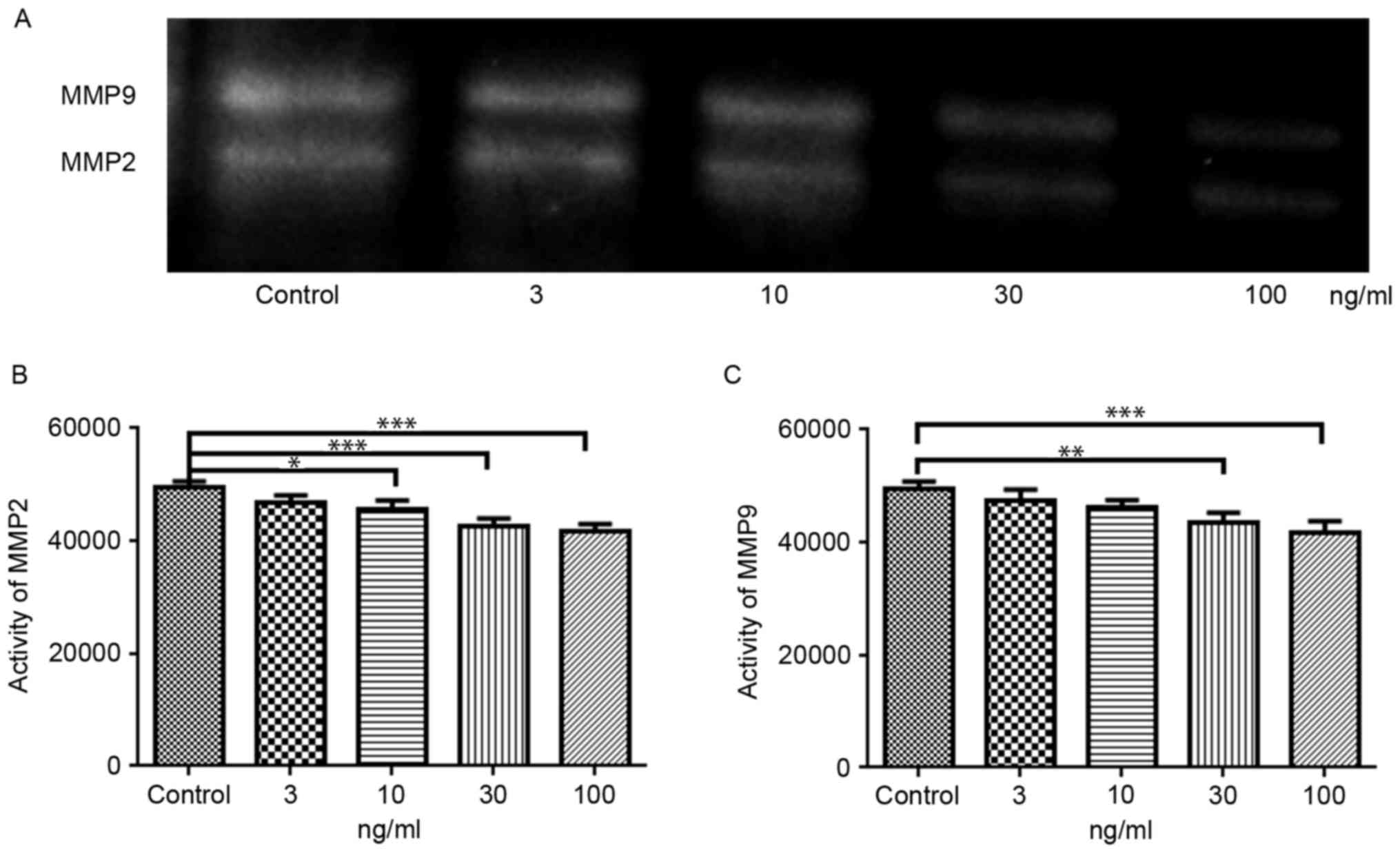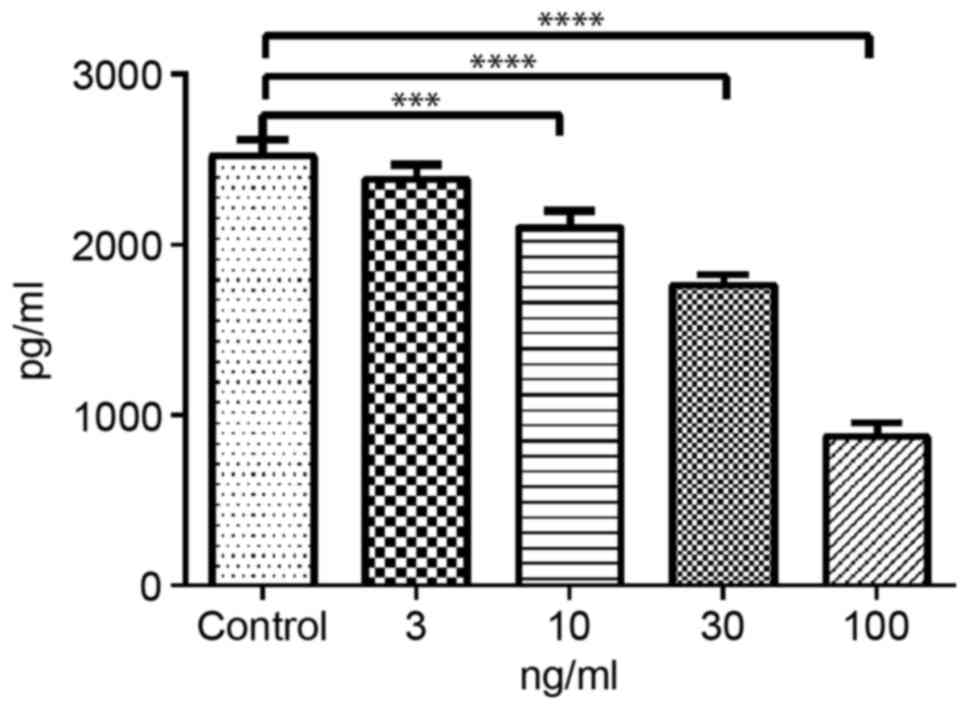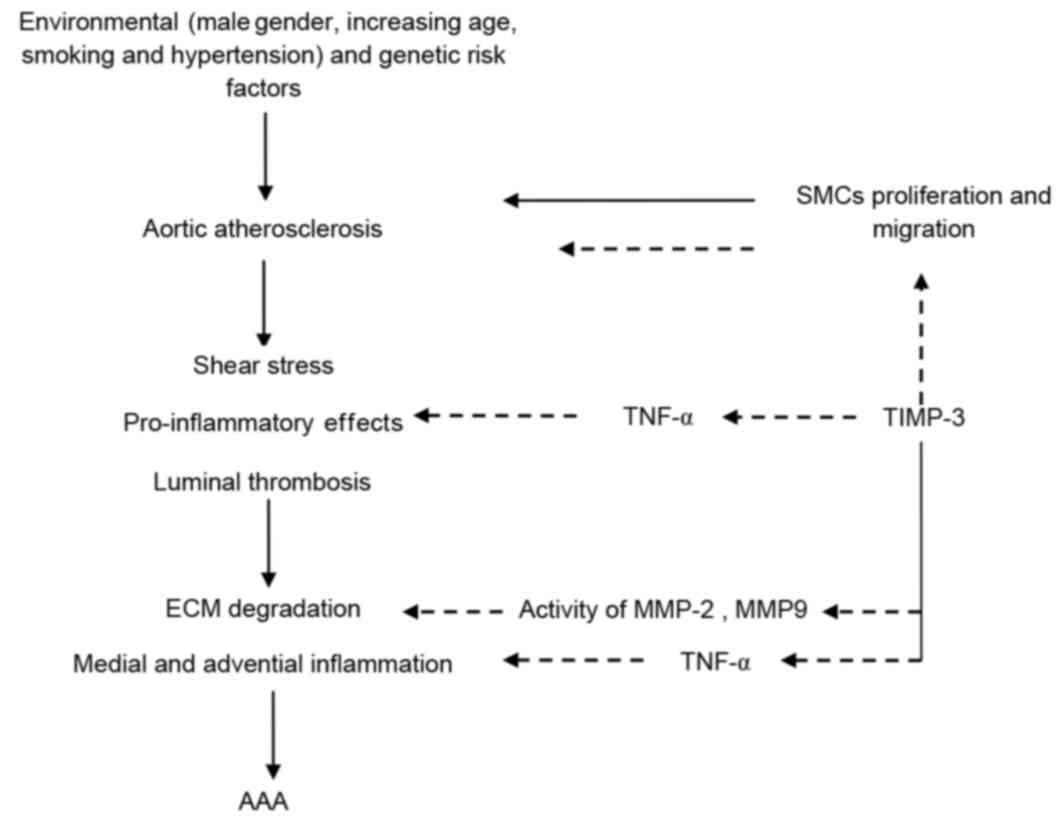|
1
|
Roggerio A, Sambiase NV, Palomino SA, de
Castro MA, da Silva ES, Stolf NG and de Lourdes Higuchi M:
Correlation of bacterial coinfection versus matrix
metalloproteinase 9 and tissue inhibitor of metalloproteinase 1
expression in aortic aneurysm and atherosclerosis. Ann Vasc Surg.
27:964–971. 2013. View Article : Google Scholar : PubMed/NCBI
|
|
2
|
Lovegrove RE, Javid M, Magee TR and Gall
RB: A meta-analysis of 21,178 patients undergoing open or
endovascular repair of abdominal aortic aneurysm. Br J Surg.
95:677–684. 2008. View
Article : Google Scholar : PubMed/NCBI
|
|
3
|
Brewster DC, Jones JE, Chung TK,
Lamuraglia GM, Kwolek CJ, Watkins MT, Hodgman TM and Cambria RP:
Long-term outcomes after endovascular abdominal aortic aneurysm
repair: The first decade. Ann Surg. 244:426–438. 2006.PubMed/NCBI
|
|
4
|
van Herwaarden JA, van de Pavoordt ED,
Waasdorp EJ, Vos Albert J, Overtoom TT, Kelder JC, Moll FL and de
Vries JP: Long-term single-center results with AneuRx endografts
for endovascular abdominal aortic aneurysm repair. J Endovasc Ther.
14:307–317. 2007. View Article : Google Scholar : PubMed/NCBI
|
|
5
|
Peterson BG, Matsumura JS, Brewster DC and
Makaroun MS: Excluder Bifurcated Endoprosthesis Invistigators:
Five-year report of a multicenter controlled clinical trial of open
versus endovascular treatment of abdominal aortic aneurysms. J Vasc
Surg. 45:885–890. 2007. View Article : Google Scholar : PubMed/NCBI
|
|
6
|
White RA, Donayre CE, Walot I, Kopchok GE,
Wilson EP and deVirgilio C: Regression of an abdominal aortic
aneurysm after endograft exclusion. J Vasc Surg. 26:133–137. 1997.
View Article : Google Scholar : PubMed/NCBI
|
|
7
|
Rodway AD, Powell JT, Brown LC and
Greenhalgh RM: Do abdominal aortic aneurysm necks increase in size
faster after endovascular than open repair? Eur J Vasc Endovasc
Surg. 35:685–693. 2008. View Article : Google Scholar : PubMed/NCBI
|
|
8
|
Diehm N, Dick F, Katzen BT, Schmidli J,
Kalka C and Baumgartner I: Aortic neck dilatation after
endovascular abdominal aortic aneurysm repair: A word of caution. J
Vasc Surg. 47:886–892. 2008. View Article : Google Scholar : PubMed/NCBI
|
|
9
|
Badran MF, Gould DA, Raza I, McWilliams
RG, Brown O, Harris PL, Gilling-Smith GL, Brennan J, White D,
Meakin S and Rowlands PC: Aneurysm neck diameter after endovascular
repair of abdominal aortic aneurysms. J Vasc Interv Radiol.
13:887–892. 2002. View Article : Google Scholar : PubMed/NCBI
|
|
10
|
Conners MS III, Sternbergh WC III, Carter
G, Tonnessen BH, Yoselevitz M and Money SR: Endograft migration one
to four years after endovascular abdominal aortic aneurysm repair
with the AneuRx device: A cautionary note. J Vasc Surg. 36:476–484.
2002. View Article : Google Scholar : PubMed/NCBI
|
|
11
|
Tanaka A, Hasegawa T, Morimoto K, Bao W,
Yu J, Okita Y, Tabata Y and Okada K: Controlled release of ascorbic
acid from gelatin hydrogel attenuates abdominal aortic aneurysm
formation in rat experimental abdominal aortic aneurysm model. J
Vasc Surg. 60:749–758. 2014. View Article : Google Scholar : PubMed/NCBI
|
|
12
|
Tsarouhas K, Soufla G, Apostolakis S,
Zaravinos A, Panagiotou M, Khoury M, Hassoulas JA, Tsatsakis AM and
Spandidos DA: Transcriptional regulation of TIMPs in ascending
aorta aneurysms. Thromb Res. 126:399–405. 2010. View Article : Google Scholar : PubMed/NCBI
|
|
13
|
Raffetto JD and Khalil RA: Matrix
metalloproteinases and their inhibitors in vascular remodeling and
vascular disease. Biochem Pharmacol. 75:346–359. 2008. View Article : Google Scholar : PubMed/NCBI
|
|
14
|
Scott RA, Paderi JE, Sturek M and Panitch
A: Decorin mimic inhibits vascular smooth muscle proliferation and
migration. PLoS One. 8:e824562013. View Article : Google Scholar : PubMed/NCBI
|
|
15
|
Saratzis A, Abbas AA, Kiskinis D, Melas N,
Saratzis N and Kitas GD: Abdominal aortic aneurysm: A review of the
genetic basis. Angiology. 62:18–32. 2011. View Article : Google Scholar : PubMed/NCBI
|
|
16
|
Doran AC, Meller N and McNamara CA: Role
of smooth muscle cells in the initiation and early progression of
atherosclerosis. Arterioscler Thromb Vasc Biol. 28:812–819. 2008.
View Article : Google Scholar : PubMed/NCBI
|
|
17
|
Sahin U, Weskamp G, Kelly K, Zhou HM,
Higashiyama S, Peschon J, Hartmann D, Saftig P and Blobel CP:
Distinct roles for ADAM10 and ADAM17 in ectodomain shedding of six
EGFR ligands. J Cell Biol. 164:769–779. 2004. View Article : Google Scholar : PubMed/NCBI
|
|
18
|
Leco KJ, Khokha R, Pavloff N, Hawkes SP
and Edwards DR: Tissue inhibitor of metalloproteinases-3 (TIMP-3)
is an extracellular matrix-associated protein with a distinctive
pattern of expression in mouse cells and tissues. J Biol Chem.
269:9352–9360. 1994.PubMed/NCBI
|
|
19
|
Yu WH, Yu S, Meng Q, Brew K and Woessner
JF Jr: TIMP-3 binds to sulfated glycosaminoglycans of the
extracellular matrix. J Biol Chem. 275:31226–31232. 2000.
View Article : Google Scholar : PubMed/NCBI
|
|
20
|
Cardellini M, Menghini R, Martelli E,
Casagrande V, Marino A, Rizza S, Porzio O, Mauriello A, Solini A,
Ippoliti A, et al: TIMP3 is reduced in atherosclerotic plaques from
subjects with type 2 diabetes and increased by SirT1. Diabetes.
58:2396–2401. 2009. View Article : Google Scholar : PubMed/NCBI
|
|
21
|
Knox JB, Sukhova GK, Whittemore AD and
Libby P: Evidence for altered balance between matrix
metalloproteinases and their inhibitors in human aortic diseases.
Circulation. 95:205–212. 1997. View Article : Google Scholar : PubMed/NCBI
|
|
22
|
Ikonomidis JS, Jones JA, Barbour JR,
Stroud RE, Clark LL, Kaplan BS, Zeeshan A, Bavaria JE, Gorman JH
III, Spinale FG and Gorman RC: Expression of matrix
metalloproteinases and endogenous inhibitors within ascending
aortic aneurysms of patients with bicuspid or tricuspid aortic
valves. J Thorac Cardiovasc Surg. 133:1028–1036. 2007. View Article : Google Scholar : PubMed/NCBI
|
|
23
|
Mahller YY, Vaikunth SS, Ripberger MC,
Baird WH, Saeki Y, Cancelas JA, Crombleholme TM and Cripe TP:
Tissue inhibitor of metalloproteinase-3 via oncolytic herpesvirus
inhibits tumor growth and vascular progenitors. Cancer Res.
68:1170–1179. 2008. View Article : Google Scholar : PubMed/NCBI
|
|
24
|
Bi Y, Zhong H, Xu K, Ni Y, Qi X, Zhang Z
and Li W: Performance of a modified rabbit model of abdominal
aortic aneurysm induced by topical application of porcine elastase:
5-month follow-up study. Eur J Vasc Endovasc Surg. 45:145–152.
2013. View Article : Google Scholar : PubMed/NCBI
|
|
25
|
Johnsen SH, Forsdahl SH, Singh K and
Jacobsen BK: Atherosclerosis in abdominal aortic aneurysms: A
causal event or a process running in parallel? The Tromso study.
Arterioscler Thromb Vasc Biol. 30:1263–1268. 2010. View Article : Google Scholar : PubMed/NCBI
|
|
26
|
Golledge J, Clancy P, Moran C, Biros E,
Rush C, Walker P and Norman P: The novel association of the
chemokine CCL22 with abdominal aortic aneurysm. Am J Pathol.
176:2098–2106. 2010. View Article : Google Scholar : PubMed/NCBI
|
|
27
|
Biros E, Moran CS, Rush CM, Gäbel G,
Schreurs C, Lindeman JH, Walker PJ, Nataatmadja M, West M, Holdt
LM, et al: Differential gene expression in the proximal neck of
human abdominal aortic aneurysm. Atherosclerosis. 233:211–218.
2014. View Article : Google Scholar : PubMed/NCBI
|
|
28
|
Karki R, Jeon ER and Kim DW: Nelumbo
nucifera leaf extract inhibits neointimal hyperplasia through
modulation of smooth muscle cell proliferation and migration.
Nutrition. 29:268–275. 2013. View Article : Google Scholar : PubMed/NCBI
|
|
29
|
Saracini C, Bolli P, Sticchi E, Pratesi G,
Pulli R, Sofi F, Pratesi C, Gensini GF, Abbate R and Giusti B:
Polymorphisms of genes involved in extracellular matrix remodeling
and abdominal aortic aneurysm. J Vasc Surg. 55:171–179.e2. 2012.
View Article : Google Scholar : PubMed/NCBI
|
|
30
|
Riches K, Angelini TG, Mudhar GS, Kaye J,
Clark E, Bailey MA, Sohrabi S, Korossis S, Walker PG, Scott DJ and
Porter KE: Exploring smooth muscle phenotype and function in a
bioreactor model of abdominal aortic aneurysm. J Transl Med.
11:2082013. View Article : Google Scholar : PubMed/NCBI
|
|
31
|
Kang YH, Yang IJ and Shin HM: Herbal
formula HMC05 prevents human aortic smooth muscle cell migration
and proliferation by inhibiting the ERK1/2 MAPK signaling cascade.
J Nat Med. 66:177–184. 2012. View Article : Google Scholar : PubMed/NCBI
|
|
32
|
Goetze S, Xi XP, Kawano Y, Kawano H, Fleck
E, Hsueh WA and Law RE: TNF-alpha-induced migration of vascular
smooth muscle cells is MAPK dependent. Hypertension. 33:183–189.
1999. View Article : Google Scholar : PubMed/NCBI
|
|
33
|
Hingorani A, Ascher E, Scheinman M,
Yorkovich W, DePippo P, Ladoulis CT and Salles-Cunha S: The effect
of tumor necrosis factor binding protein and interleukin-1 receptor
antagonist on the development of abdominal aortic aneurysms in a
rat model. J Vasc Surg. 28:522–526. 1998. View Article : Google Scholar : PubMed/NCBI
|
|
34
|
Hultin MB, Shapiro SS, Bowman HS, Gill FM,
Andrews AT, Martinez J, Eyster EM and Sherwood WC:
Immunosuppressive therapy of Factor VIII inhibitors. Blood.
48:95–108. 1976.PubMed/NCBI
|
|
35
|
Zhong H, Matsui O, Xu K, Ogi T, Sanada J,
Okamoto Y, Tabata Y and Takuwa Y: Gene transduction into aortic
wall using plasmid-loaded cationized gelatin hydrogel-coated
polyester stent graft. J Vasc Surg. 50:1433–1443. 2009. View Article : Google Scholar : PubMed/NCBI
|



